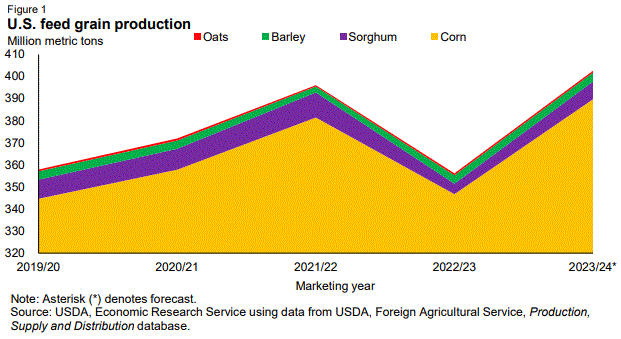The 2023/24 U.S. feed grains production estimate is raised this month to 402.6 million metric tons. This increase is attributed to gains in the corn crop, which is slightly offset by a reduction in sorghum output. Complemented by a slight bump in beginning stocks, total feed grains supply is raised from 439.4 million metric tons to 442.1 million. All feed-grains-use categories are raised this month; however, such gains do not outpace the supply increase. Consequently, ending stocks are higher than last month’s forecast at 57.7 million metric tons. Earlier this month, the USDA, National Agricultural Statistics Service (NASS) released historical revisions to production and stocks from 2018–22 following the recent Agricultural Census results.
Larger projected China’s corn production boosts 2023/24 world coarse grain output. A small increase in coarse grain consumption is projected, while a sizeable increase in stocks is driven by China. However, world coarse grain ending stocks, excluding the increase for China, are projected up just slightly. Global corn trade is marginally lower and U.S. corn exports are unchanged. World sorghum trade is nudged up, with higher U.S. exports and China’s imports, while barley trade is unchanged.
Domestic Outlook
A Record Yield Is Projected for the 2023/24 U.S. Corn Crop
The 2023/24 U.S. corn production estimate is 107.3 million bushels higher this month, at 15.3 billion. An increase in the yield estimate (to a record 177.3 bushels per acre) offsets a reduced harvested area of 86.5 million acres. After accounting for slightly lower beginning stocks, total supply is projected higher, at 16.7 billion bushels.
In its January Grain Stocks report, the USDA, National Agricultural Statistics Service (NASS) reported 2023/24 first quarter corn stocks at 12.2 billion bushels. Estimated at 4.53 billion bushels, the indicated first quarter domestic corn disappearance is 7.6 percent higher year over year. In tandem with strong ethanol production, this increase is largely driven by an implied feed and residual use of 2.5 billion bushels—up 7.4 percent from last year.
Earlier this month, USDA, NASS released historical revisions to production and stocks from 2018 to 2022 following the recent Agricultural Census results (see figure 2). Following these historical revisions, and based on indicated first quarter domestic disappearance, 2023/24 feed and residual corn use is raised 25 million bushels this month to 5.7 billion.














